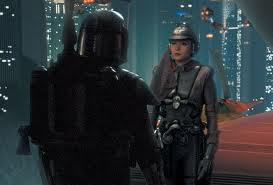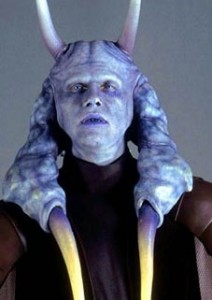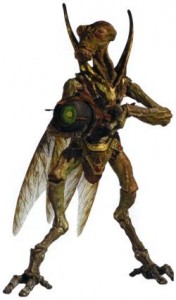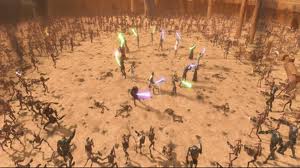 I’ve been rewatching the Star Wars prequels riding the exercise bike at night lately, and after finishing Episode II – Attack of the Clones, I’m reminded of a couple things.
I’ve been rewatching the Star Wars prequels riding the exercise bike at night lately, and after finishing Episode II – Attack of the Clones, I’m reminded of a couple things.
First, for me Attack of the Clones is by far the best of the three prequels with the back story of the start of the Clone Wars and the fantastic battle in the arena of a cohort of Jedis fighting the droid army.
But more importantly, I think the thing that makes this film so fun is that it is in fact a full-length tribute to the films of Ridley Scott, probably my favorite director. If you watch carefully, you will see references to Blade Runner, Legend, Someone to Watch Over Me, Alien, Gladiator, and Blackhawk Down. In some cases, it will be through set, lighting and character design, while in others it’s through more complete plot points.
 Blade Runner shows up first, with Obi Wan and Aniken hunting for the shape shifting assassin on Coruscant. The city scape the Jedi moves through is dark with fantastic lit up signs, a vast multicultural cast of characters, and writing clearly derived from Asian ideograms. In short, it is Blade Runner’s Los Angeles.
Blade Runner shows up first, with Obi Wan and Aniken hunting for the shape shifting assassin on Coruscant. The city scape the Jedi moves through is dark with fantastic lit up signs, a vast multicultural cast of characters, and writing clearly derived from Asian ideograms. In short, it is Blade Runner’s Los Angeles.
 Legend, I will admit, is a bit of a stretch, but there are numerous characters surrounding Senator Palpatine who follow the design of characters from Scott’s dark fantasy world, most especially the aide Mas Amedda with the classical devil horns. He has a strong resemblance to the Lord of Darkness played by the over-the-top Tim Curry.
Legend, I will admit, is a bit of a stretch, but there are numerous characters surrounding Senator Palpatine who follow the design of characters from Scott’s dark fantasy world, most especially the aide Mas Amedda with the classical devil horns. He has a strong resemblance to the Lord of Darkness played by the over-the-top Tim Curry.
Someone to Watch Over Me is a romantic drama that tells the story of forbidden love between a threatened woman and the (married) police officer assigned to protect her. After being forced into spending time together facing peril, they fall in a love, a love that is a betrayal of the policeman’s honor. This is, of course, essentially the same story of Anakin’s and Padmé’s ill-advised romance. Anakin is the Jedi police man guarding the life of the beautiful senator and former queen. While Anakin is not married, as a Jedi he is forbidden to have close, personal relationships as part of his monk-like vows.

 Like Legend, Alien shows up more through character design than plot points. On the planet Geonosis there are gargoyle like creatures serving Count Dooku who bear a striking resemblance (ignoring the wings) of the creature in Alien. The gargoyles also blend into the dark corridors of the Count’s lair in much the same way as the Alien does in the Nostromo. In addition, the organic, almost sexual, architechtural forms from the space jockey’s ship are echoed throughout the coliseum.
Like Legend, Alien shows up more through character design than plot points. On the planet Geonosis there are gargoyle like creatures serving Count Dooku who bear a striking resemblance (ignoring the wings) of the creature in Alien. The gargoyles also blend into the dark corridors of the Count’s lair in much the same way as the Alien does in the Nostromo. In addition, the organic, almost sexual, architechtural forms from the space jockey’s ship are echoed throughout the coliseum.
Gladiator is the most obvious of the references with the giant set piece of the planned execution of Obi Wan, Anakin and Padmé. The arena, the battles with animals and gladiators, the supreme leader in the emperor’s box (yes, I know Dooku is not the emperor…), and even the reblious fight of the Jedi are all powerful references to Gladiator.

Finally is the one that impresses me the most. Yoda rides to the rescue of all our heroes in a gun ship manned by the clone army in battle scenes taken straight out of the story of the disastrous raid by U.S. Marines to rescue their comrades in Blackhawk Down. The combat footage has been compared to images from World War II films, but I see a much stronger link to the helicopter combat out of Mogadishu. And to top things off, Blackhawk Down also stars actor Ewan McGregor, who plays Jedi Obi Wan Kenobe in the Star Wars prequels.

While Lucas has publicly acknowledged that the urban scenes in Attack of the Clones were explicitly designed to give homage to Blade Runner, to the best of my knowledge, this brief essay is the is the first consideration of Attack of the Clones as a much wider-spread tribute (intentional or not) to the works of Ridley Scott. Although I’m writing this a decade after the film’s initial release, I actually spouted all of this off to my wife when we first saw the movie back in 2002.
So, what do you think? Am I overreaching here? Or have I actually given a fair analysis of these films?
Post in the comments if you have a thought on the matter.
And yes, I know, I’m a geek.









